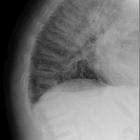athletic pubalgia









Athletic pubalgia or groin pain in athletes is a clinical syndrome of chronic lower pelvic and groin pain, usually encountered in athletes. It is either a musculotendinous or osseous injury that involves the insertion of abdominal muscles on the pubis and the upper aponeurotic insertion of the adductor muscles. Although it can occur following an acute injury, it is most often the result of repeated microtrauma.
Terminology
Athletic pubalgia was first described as Gilmore’s groin and has been commonly known as sportsman's hernia or sports hernia, although the latter two are a misnomer since an actual hernia does not occur. Groin disruption injury is another term that has fallen out of favor. More recently (c.2020) core muscle injury or groin pain in athletes have been preferred terms by some to refer to athletic pubalgia.
Epidemiology
5-23% of all sports injuries result in groin pain , groin pain is more common in males.
Risk factors
Groin pain is common in the following sports :
- football (soccer)
- ice hockey
- rugby
Clinical presentation
Athletic pubalgia is a diagnosis of exclusion. Other more important causes of groin pain must first be ruled out. The symptoms are usually very non-specific and include:
- tenderness on palpation of the medial inguinal floor
- tenderness on palpation over the pubic ramus
- exacerbated pain with resisted hip adduction
Radiographic features
The preferential imaging modality for the diagnostic workup of ‘groin pain’ in athletes is MRI, however, some helpful imaging features can be observed in other imaging modalities.
Plain radiograph/CT
- degenerative changes
- alignment abnormalities
- widening of the symphysis
- assist in excluding other causes of groin pain e.g. osteoarthritis, femoroacetabular impingement
Ultrasound
The following features can be detected on ultrasound examination :
- anechoic defects and/or partial or full-thickness discontinuities of the tendon insertions in case of tears
- loss of normal fibrillary architecture, thickening and hypoechogenicity of tendon insertions in case of tendinopathy
- spurring and irregularities of the pubic bone
- symphyseal effusion
- periarticular hyperemia on color Doppler
- reproduction of symptoms on pressure with the ultrasound transducer
Pitfalls: anisotropy on assessment for tendinosis
- protrusion of pre-peritoneal fat through the Hesselbach triangle during abdominal strain
MRI
MRI can show findings of osteitis pubis :
- subchondral bone marrow edema, involving the entire anterior-posterior diameter of the pubic bone as a result of an osseous stress response
- subchondral sclerosis and irregularities in chronic or longstanding cases
adductor tendon injury :
- thickening of tendon insertion sometimes with concomitant signal alterations as a sign of tendinosis
- partial or full-thickness tears displayed as fluid-filled defects, with or without tendon retraction
- linear fluid signal running along the inferior margin of the inferior pubic ramus known as ‘secondary cleft’
injury or tear of the aponeurotic plate :
- fluid-signal intense subperiosteal cleft running from the symphysis along the inferior margin of the superior pubic ramus also known as ‘superior cleft’
or a combination of all :
- with a cleft extension of tears or clefts from the symphyseal joint capsule into the adductor tendons or rectus abdominis muscles
It can also show insertional tendinopathy, tears and iliopsoas bursitis in iliopsoas-related groin pain.
Furthermore, the objective of MRI in the evaluation of groin pain is not only to demonstrate pathologic findings of the pubic bone, the rectus abdominis-adductor longus aponeurotic plate and the adductor insertions but also to rule out or identify potential other causes of groin pain e.g. inguinal hernias and hip-related groin pain.
Potential pitfalls
- ‘primary cleft’: developmental cleft in the posterosuperior central portion of the symphysis
Treatment and prognosis
Depending on the site of injury and the final diagnosis there are different treatment options.
Adductor-related groin pain can be treated with supervised active physical training, multimodal treatment including adductor manipulation or operatively with a partial release.
Pubic related groin pain can be treated with a pubic symphyseal injection.
Inguinal related groin pain can be treated with laparoscopic hernia repair.
Differential diagnosis
Causes of groin pain in athletes are divided into three categories:
- adductor-related
- pubic-related
- iliopsoas-related
- inguinal-related
- piriformis syndrome
- pelvis stress or insufficiency fracture
See also
Siehe auch:
- Osteomyelitis
- Femoro-acetabuläres Impingement
- primärer Hyperparathyreoidismus
- osteitis pubis
- Insuffizienzfraktur
- Piriformis-Syndrom
- Bridging of symphysis pubis
- stress
und weiter:

 Assoziationen und Differentialdiagnosen zu Leistenschmerz bei Sportlern:
Assoziationen und Differentialdiagnosen zu Leistenschmerz bei Sportlern:






